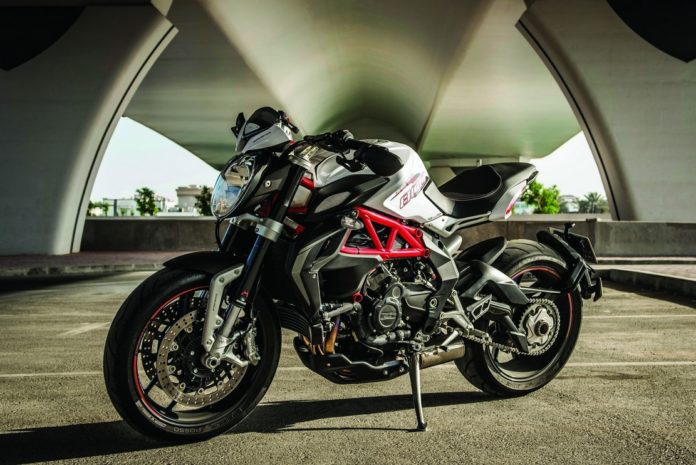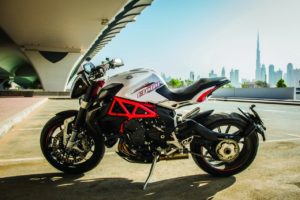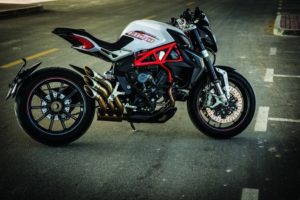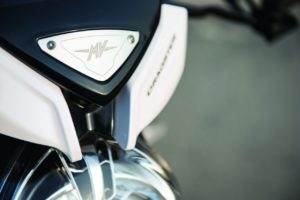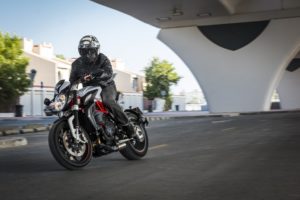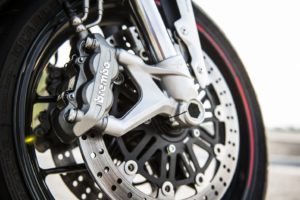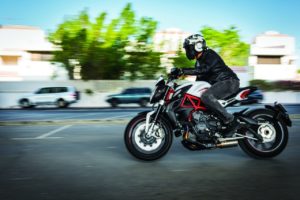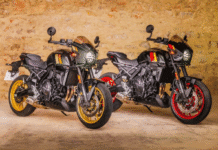We all have our preferences when it comes to brands and our reasons to like them. How we see certain motorcycles depends on a lot of things that shape our perception of that brand and that product. However, no matter which is your brand of choice, there’s no denying that you will find all MV Agusta motorcycles good looking. The design division at MV Agusta is doing a fantastic job on every motorcycle that leaves the factory. The Brutale Dragster isn’t any exception. It is the second most beautiful motorcycle we’ve ridden this year, after the Brutale 800 we had on the cover of issue 4 of Bike Nation Magazine.
When you think of a Dragster, you get visions of a motorcycle on a drag strip, throttle wide open, engine at peak revs, the rear wheel spinning as it tries to gain traction. That’s not what the Brutale Dragster is all about though. It is a variation of the Brutale family but there’s a lot to tell it apart from the standard Brutale range.
Over the last few years, MV Agusta has expanded its motorcycle range to add new nameplates to the family. After introducing the Rivale 800, a symbol of motard-style sports appeal and dynamic road performance, the Brutale 800 Dragster adds a new muscular dimension to the Brutale range. The Brutale Dragster is designed to offer good rideability, controlled power, lightness, eye-catching design, and value for money. It is termed as the most extreme Brutale ever and while the standard Brutale 800 deserves the Bella Figura title and adds a bit more finesse to the overall look, the Dragster is about being brawny and brash. It pays homage to the first 4-cylinder Brutale bikes which were aggressive, in your face and strikingly good looking.
With its Brutale 3-cylinder platform, MV Agusta has demonstrated how completely original models can be derived from the same, shared technological base. MV Augusta’s goals for the Brutale Dragster are highly ambitious: performance at the top of the respective displacement categories, maximum elasticity, low fuel consumption and a torque curve spread evenly across the power range. Does it achieve all of this? Maybe. While that engine is fantastic, the Japanese offer a smoother 4-cylinder layout that’s equally loud, powerful and fuel efficient. What you do get with the Brutale Dragster is a unique 3-cylinder layout which is rivalled only by Triumph with its Street and Speed Triple range. In terms of looks, nothing beats the MV Agusta range and that’s one of the strongest points of this brand. Attention to detail on the Brutale Dragster is also one of the best in this segment. You notice small little things that make you smile and appreciate the level of detail that goes into building an MV Agusta.
There’s quite a lot of technical innovation that MV Agusta offers with this engine. Key technical features include the shell-cast closed-deck crankcase with integral bore liners; the need for compactness has also imposed full integration of the water and oil circuits and their respective pumps. Just as significant, and exclusive, is the counter-rotating crankshaft, a solution from the racing world where ride responsiveness has absolute priority. The counter-rotating crankshaft reduces inertia during changes of direction because it lowers that inertia during deceleration.
Compared to previous 3-cylinder configurations, the one specially developed for the Brutale 800 Dragster focuses on fast-response, linear power output, putting a mighty roar into this roadster. The 125hp power peak is reached at 11,600 rpm, while the maximum torque of 81Nm comes at 8,600 rpm. Completing this highly sophisticated package is the cassette type 6-speed gearbox, with ratios designed to ensure awesome acceleration and a sports-category top speed if an owner ever decides to blast it around the track.
The MVICS platform on the Brutale Dragster also features the Eldor EM2.0 engine control unit and a Mikuni Full Ride-By-Wire throttle body. Fully integrated control allows easy adjustment of numerous user-settable parameters. More specifically, the system lets the rider configure the torque setting with four different mappings. Three of these are set directly by the MV Agusta and named according to the relative riding conditions, Sport, Normal and Rain, while the fourth leaves the rider free to define, within established limits, all the individual parameters: engine response, rev limiter, engine torque response, throttle sensitivity, engine braking.
Photography: Laura Huntley


